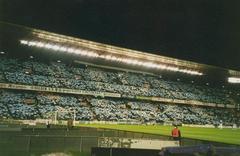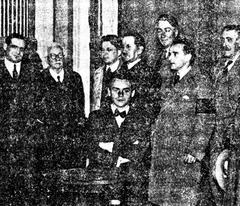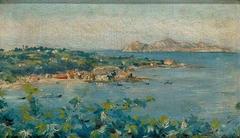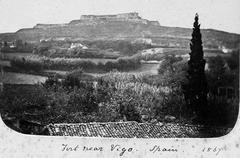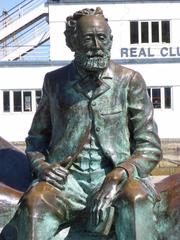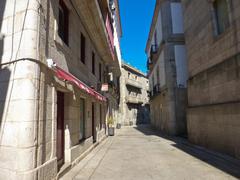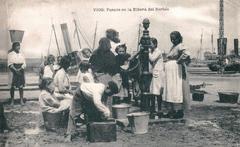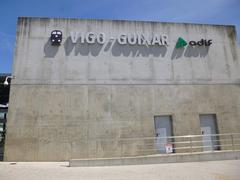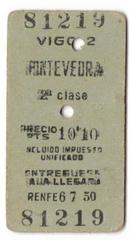
Edificio Albo Vigo, Spain: Visiting Hours, Tickets, and Historical Guide
Date: 04/07/2025
Introduction: Edificio Albo’s Legacy in Vigo
At the intersection of Gran Vía and Urzáiz in central Vigo, Edificio Albo rises as a monumental testament to the city’s postwar transformation and architectural ambition. Designed by Francisco Castro Represas and Pedro Alonso Pérez, and commissioned by the influential Albo family, this landmark completed in 1949 embodies the resilience and modernization of Vigo during a period of economic challenge. Blending rationalist modernism with regional neo-baroque detail, Edificio Albo reflects both the aspirations of Vigo’s industrial class and the evolution of Galician architectural identity. Its granite façade, distinctive corner design, and the crowning replica of Jesús Picón’s “Victoria de Samotracia” make it an essential point of interest for visitors seeking to engage with the city’s heritage (Concello de Vigo; Vigo Tourism Official Site; Loving Vigo).
Table of Contents
- Introduction and Historical Overview
- Location and How to Get There
- Visiting Hours & Ticket Information
- Accessibility
- Architectural Highlights and History
- Visitor Experience and Guided Tours
- Photography Tips
- Nearby Attractions and Activities
- Practical Tips for Visitors
- Frequently Asked Questions (FAQ)
- Conclusion and Recommendations
- References
Location and Directions
Edificio Albo is prominently located at Av. da Gran Vía, 2, 36201 Vigo, Pontevedra, Spain, on the corner of Gran Vía and Urzáiz—the heart of the city’s commercial and cultural life (Loving Vigo; Edificio El Cedro). Its central placement ensures easy access to public transit, major roads, and pedestrian routes, making it an ideal starting point for exploring Vigo.
Getting There:
- By Public Transport: Multiple city bus lines and taxis serve Gran Vía and Urzáiz. The Vigo-Urzaiz railway station is within walking distance.
- By Car: Street parking is limited; public parking garages nearby are recommended.
- On Foot: The building is easily accessible from key city landmarks and is part of many walking itineraries.
Visiting Hours and Tickets
Edificio Albo is primarily a residential and commercial property, not a museum or public exhibition space. Therefore:
- Exterior Viewing: Accessible at any time; best experienced during daylight hours for optimal appreciation and photography.
- Interior Access: Generally restricted to residents and businesses. Occasionally, cultural events or heritage days allow guided interior tours—check Vigo’s official tourism site for updates.
- Admission: No fees or tickets are required to view the exterior.
Accessibility
- Mobility: The area around Edificio Albo features broad, paved sidewalks and ramps. While the interior is private, exterior viewing is accessible to visitors with mobility needs (Edificio El Cedro).
- Transport: Convenient connections via bus, train, taxi, and city bike-sharing.
- Parking: Public garages are preferable due to limited street parking, especially during peak hours.
Architectural Highlights and History
Construction Timeline and Social Context:
- Built between 1942 and 1949 amid postwar economic constraints, Edificio Albo’s development reflected the era’s resourcefulness and ambition (Concello de Vigo).
- The Albo family, prominent in Vigo’s canning industry, commissioned the project to symbolize urban progress and economic resilience.
Architectural Style:
- Rationalism: The building’s geometric, symmetrical layout and use of reinforced concrete highlight modernist influences.
- Regional Neo-Baroque: Decorative balconies, granite cladding, divided pediments, and volutes express regional identity and historical continuity.
- Corner Design: Its rounded-to-angled transition at the intersection is visually striking and functional.
- Monumental Sculpture: The crowning “Victoria de Samotracia” replica by Xesús Picón serves as a symbol of triumph and aspiration.
Cultural Role:
- Edificio Albo is a protected heritage site and a key stop on architectural and historical walking tours, representing Vigo’s postwar rebirth (Loving Vigo; Faro de Vigo).
Visitor Experience and Guided Tours
- Exterior Appreciation: Visitors are encouraged to study the building’s ornate details, especially the balconies, granite work, and rooftop sculpture.
- Guided Tours: Occasionally offered by local cultural groups during festivals or special events—check Vigo’s tourism site or local listings for schedules.
- Informational Plaques: Some on-site signage provides historical context.
Photography Tips
- Optimal Lighting: Early morning or late afternoon enhances the building’s textures and relief.
- Best Angles: The intersection of Gran Vía and Urzáiz provides excellent vantage points to capture the building’s silhouette and unique corner.
- Equipment: A wide-angle lens is recommended to capture the full façade.
Nearby Attractions and Activities
Within Walking Distance:
- Casco Vello (Old Town): Explore Vigo’s historic center with its winding streets, lively plazas, and local markets (Passaporte no Bolso).
- O Halo Panoramic Walkway: Award-winning urban walkway and elevator system offering panoramic city and estuary views (OnlyByLand; Discovering Vigo).
- Monte O Castro: Ancient ruins, fortress, and gardens with sweeping views of the city.
- MARCO Museum: Contemporary art exhibitions housed in a former courthouse.
- Mercado da Pedra: Savor fresh oysters and local cuisine.
- Alameda Park: Green space and Sunday market.
Other Recommendations:
- Shopping: Rúa Príncipe and Gran Vía feature boutiques and international brands.
- Nightlife: Churruca Street for live music; Alameda district for wine bars.
- Ferry Excursions: Boat trips to Cíes Islands and beaches like Playa de Samil (Travellerspoint).
Practical Tips for Visitors
- Best Time to Visit: Spring and early autumn offer mild weather; early mornings and evenings are ideal for photos.
- Weather: Vigo’s oceanic climate brings rain, especially from October to January—pack accordingly.
- Language: Spanish and Galician are spoken; English is common in tourist areas.
- Safety: Vigo is generally safe; usual precautions apply in busy districts (OnlyByLand).
- Tourist Info: Centers near the port and Rúa Príncipe provide maps and guidance (Turismo de Vigo).
Frequently Asked Questions (FAQ)
Q: Can visitors enter Edificio Albo?
A: Interior access is limited to residents and businesses. Exterior viewing is open at all times.
Q: Are there tickets or entrance fees?
A: No, exterior viewing is free. Tickets may be required for special event access.
Q: Is Edificio Albo accessible for people with disabilities?
A: Yes, the surrounding area is accessible; interior access is generally restricted.
Q: Are guided tours available?
A: Occasionally, especially during festivals or heritage days—check local tourism sites.
Q: What are the best nearby attractions?
A: Casco Vello, O Halo, Monte O Castro, MARCO, Mercado da Pedra, and Vigo’s port area.
Conclusion and Recommendations
Edificio Albo is a cornerstone of Vigo’s architectural and cultural narrative, emblematic of the city’s postwar resilience and ambition. While its primary function remains residential and commercial, its monumental façade and strategic location make it a must-see for visitors. Combine your visit with exploration of nearby historical, cultural, and culinary highlights to experience the essence of Vigo. For updates on special events, guided tours, and practical information, consult the Vigo city website and Concello de Vigo. Enhance your visit with the Audiala app for interactive tours and real-time guidance.
References
- This guide draws on authoritative sources, including Concello de Vigo, Vigo Tourism Official Site, Loving Vigo, OnlyByLand, Discovering Vigo, Faro de Vigo, Passaporte no Bolso, Travellerspoint, Edificio El Cedro, and Turismo de Vigo.






